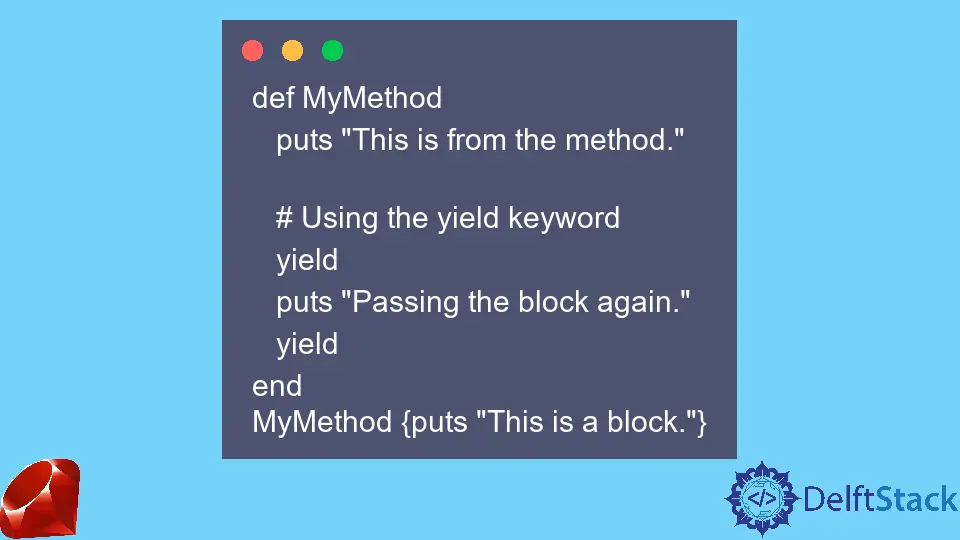yield in Ruby
- What is a Block in Ruby?
- Understanding Yield in Ruby
- Using Blocks and Yield Together
- Advantages of Using Yield and Blocks
- Conclusion
- FAQ

In the world of Ruby programming, understanding the concepts of blocks and the yield keyword is essential for writing efficient and elegant code. Blocks are anonymous pieces of code that can accept parameters and are often used to encapsulate behavior. The yield keyword, on the other hand, is a powerful tool that allows methods to delegate execution to the block passed to them.
This tutorial will delve into these concepts, providing clear examples and detailed explanations to help you grasp how to effectively use yield and blocks in your Ruby applications. Whether you are a beginner or an experienced Rubyist, mastering these concepts will enhance your coding skills and enable you to write more dynamic and reusable code.
What is a Block in Ruby?
A block in Ruby can be thought of as a chunk of code that you can pass to methods. Blocks can take arguments and can be defined using either braces {} or the do...end syntax. They are not objects themselves but can be converted into Proc objects. Blocks are particularly useful for creating reusable code snippets that can operate on different data.
Here’s a simple example of a block being used in Ruby:
def greet(name)
yield(name)
end
greet("Alice") do |n|
puts "Hello, #{n}!"
end
Output:
Hello, Alice!
In this example, the greet method takes a name as an argument and then calls yield(name), passing the name to the block defined at the method call. The block then outputs a greeting. This flexibility allows you to encapsulate behaviors and create methods that can operate differently based on the block passed to them.
Understanding Yield in Ruby
The yield keyword is used within a method to transfer control from the method to the block that was passed to it. When a method calls yield, it can also pass arguments to the block. This creates a powerful mechanism for writing flexible and reusable code.
Consider this example:
def calculate_area(length, width)
yield(length * width)
end
calculate_area(5, 10) do |area|
puts "The area is #{area} square units."
end
Output:
The area is 50 square units.
In this code, the calculate_area method computes the area of a rectangle and then yields that value to the block. The block takes the area as an argument and prints it. This separation of logic allows for cleaner code and better organization of functionality.
Using Blocks and Yield Together
Combining blocks and yield can lead to powerful abstractions in Ruby. By leveraging both, you can create methods that are not only reusable but also highly customizable based on the behavior defined in the block. Here’s an example that demonstrates this concept:
def process_numbers(numbers)
numbers.each do |number|
yield(number)
end
end
process_numbers([1, 2, 3, 4, 5]) do |num|
puts "Number: #{num * 2}"
end
Output:
Number: 2
Number: 4
Number: 6
Number: 8
Number: 10
In this example, the process_numbers method iterates over an array of numbers and yields each number to the block. The block then doubles each number and prints it. This approach allows you to define the processing behavior externally, making the method reusable for different operations.
Advantages of Using Yield and Blocks
Using yield and blocks in Ruby has several advantages. First, it promotes cleaner code by separating the implementation of a method from its behavior. This separation allows for more straightforward testing and maintenance. Additionally, blocks can enhance performance by reducing the need for additional method calls, as the code contained in the block executes inline.
Moreover, blocks can lead to more expressive code. Instead of creating multiple methods for different behaviors, you can create a single method that accepts a block, allowing you to customize its behavior on the fly. This flexibility is one of the reasons why Ruby is such a beloved language among developers.
Conclusion
Understanding yield and blocks in Ruby is crucial for any developer looking to harness the full power of the language. These concepts not only enhance code readability and maintainability but also enable you to create more dynamic and reusable methods. By practicing these techniques, you’ll find yourself writing cleaner, more efficient Ruby code in no time. Embrace the power of yield and blocks, and take your Ruby programming skills to the next level.
FAQ
-
What is a block in Ruby?
A block is a chunk of code that can be passed to methods, allowing for flexible behavior. -
How does the yield keyword work?
The yield keyword transfers control from a method to the block passed to it, allowing the method to pass arguments to the block. -
Can a method have multiple blocks?
No, a method can only accept one block, but you can use additional arguments to achieve similar functionality. -
Why are blocks useful in Ruby?
Blocks allow for cleaner and more flexible code by separating behavior from implementation, which enhances code reusability. -
How do I convert a block to a Proc object?
You can convert a block to a Proc object by using theProc.newmethod or the&operator.
Aminul Is an Expert Technical Writer and Full-Stack Developer. He has hands-on working experience on numerous Developer Platforms and SAAS startups. He is highly skilled in numerous Programming languages and Frameworks. He can write professional technical articles like Reviews, Programming, Documentation, SOP, User manual, Whitepaper, etc.
LinkedIn